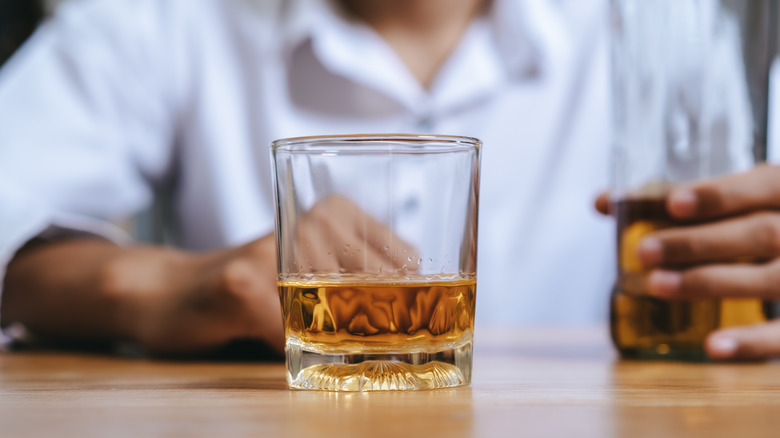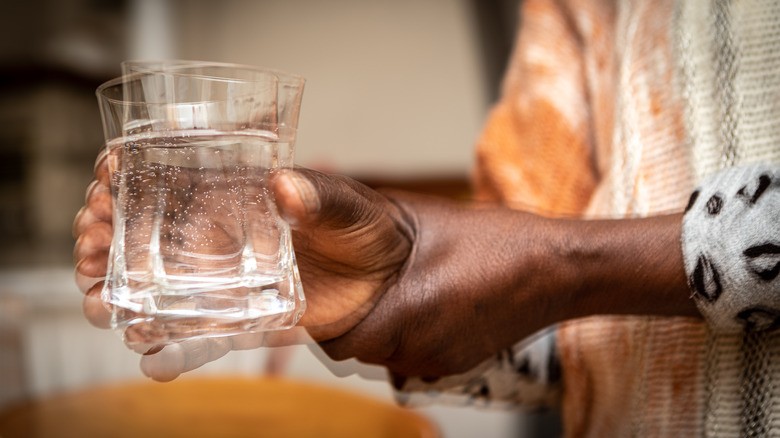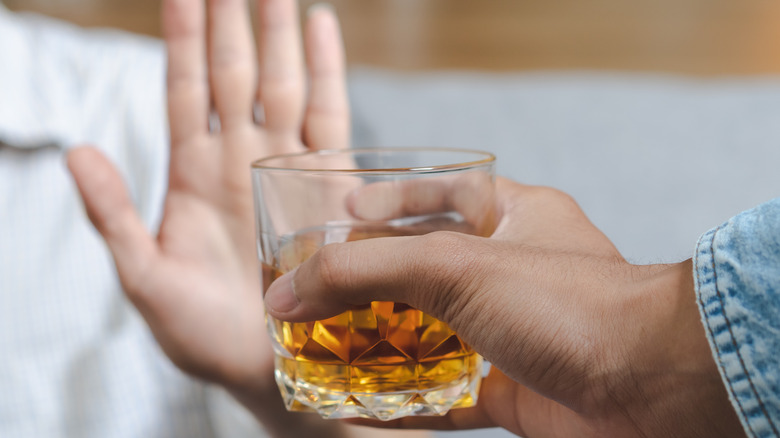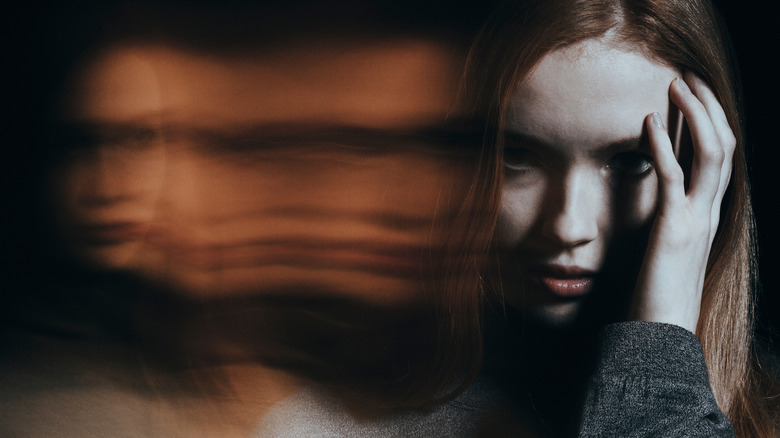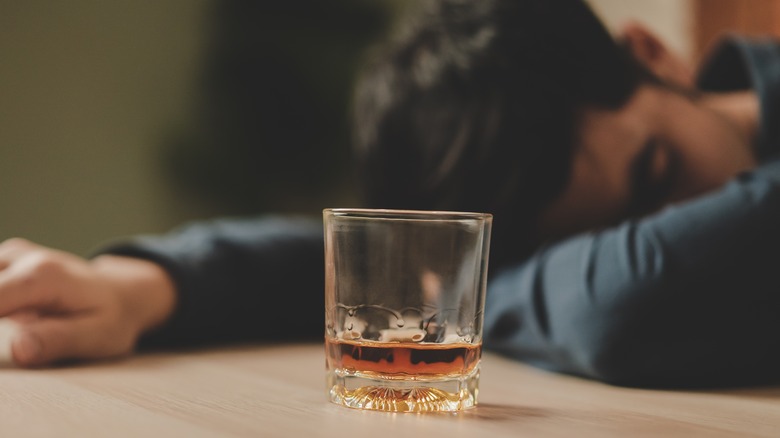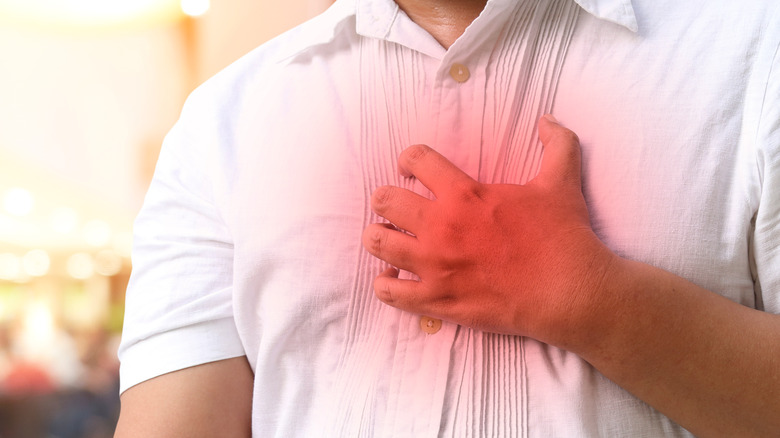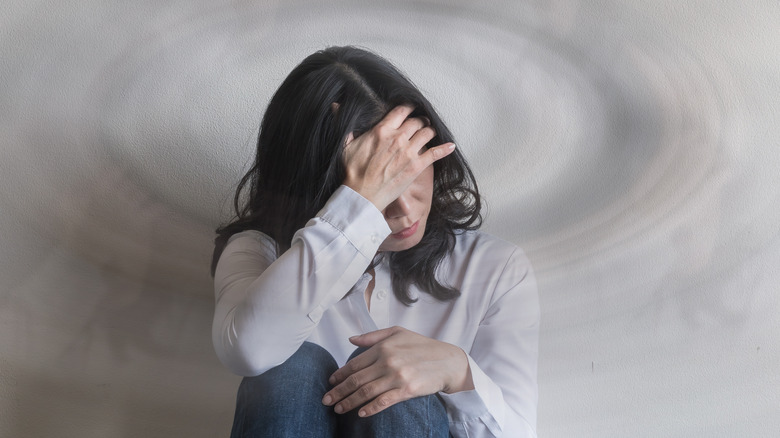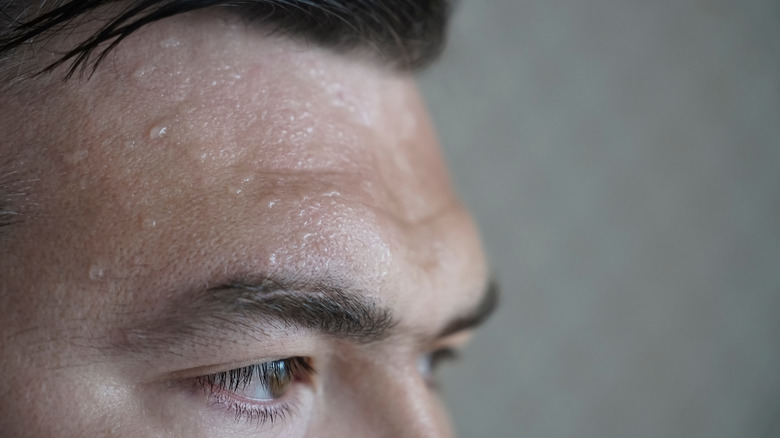Symptoms Of Alcohol Withdrawal Explained
Alcohol withdrawal can rear its ugly head in a wide spectrum of ways (via the Cleveland Clinic Journal of Medicine). Nausea, dizziness, insomnia, and tremors are just some of the unpleasant symptoms that can emerge when you suddenly stop drinking after prolonged and heavy alcohol use.
Alcohol withdrawal can affect you both physically and emotionally, and varies from person to person. Mild to moderate symptoms typically start within six and 12 hours of cessation, whereas more serious symptoms develop somewhere between 48 and 72 hours. Ultimately, there are no hard or fast rules: For some people, withdrawal symptoms can occur as early as two hours or as late as five days after their last sip of alcohol. These may subside a few hours later or spill across several days. It's estimated that 80% of patients abstaining from alcohol in hospital are likely to develop alcohol withdrawal syndrome. To qualify for a diagnosis, a person must be facing emotional distress or impairment of normal functioning in their day-to-day life (via American Family Physician).
The severity and duration of alcohol withdrawal syndrome often depends on how long and regularly a person drank, as well as their current health and lifestyle, notes The Recovery Village. For some people, it can have some pretty serious and even life-threatening health consequences. Read on to find out what happens to your body and brain as they undergo various changes during alcohol withdrawal.
Tremors
Alcohol withdrawal symptoms tend to peak somewhere between the first 10 and 30 hours after cessation, according to DrugRehab.com. Some symptoms can persist for a longer period of time like tremors, also known as "the shakes." This is one of the most visible signs of alcohol withdrawal, and it can start to show up in people just a few hours after they had their last drink. Although physical tremors can occur in drinkers of all levels of consumption and dependency, they're most common among moderate to severe drinkers. Tremors usually affect the hands, but they can occur in other parts of the body too. Some people may have difficulty holding things or writing.
Alcohol works as a depressant by stimulating the release of GABA, which inhibits the nervous system and prevents the release of glutamate, the brain's main excitatory neurotransmitter (via Brain Plasticity). Prolonged alcohol use leads to GABA receptors becoming less responsive. So, when a person stops drinking, glutamate receptors increase in number, causing excitatory neurotransmission to spike. This sends the sympathetic nervous system into overdrive, resulting in symptoms like the shakes.
Less commonly, uncontrolled shaking might signal a serious health problem related to chronic alcohol use, such as brain damage or liver disease (via DrugRehab.com). This can cause a person to slowly flap their hands up and down when trying to hold their arms out in front of them, a condition known as "asterixis."
Anxiety
Anxiety is one of the tell-tale signs of alcohol withdrawal, per The Recovery Village. Alcohol exerts a sedative effect on the brain, suppressing certain neurotransmitters which, in turn, induces feelings of drunkenness. For this reason, many people use alcohol to help them relax and feel less anxious.
But chronic and excessive use plays havoc with the central nervous system. The long-term drinker's brain is continually experiencing the depressant effects of alcohol, which leads to dependency over time. When alcohol is no longer being consumed, the brain experiences a chemical imbalance, causing the person to become anxious again, maybe even more so than before. Some people may feel flat, agitated, or restless (via American Family Physician). More severely, some individuals start to experience panic attacks.
Alcohol also boosts dopamine, the neurotransmitter that motivates us to repeat certain behaviors or experiences by creating a sense of reward (via The Recovery Village). Dopamine contributes towards dependency by activating the brain's memory circuits, so that you remember the satisfaction you got from drinking. Over time, repeated alcohol consumption causes dopamine levels to drop, which can make your mood plummet. A disrupted dopaminergic system often underlies a number of physical and emotional problems.
Nausea
Many people who are withdrawing from alcohol feel nauseous at some point, reports The Recovery Village. Heavy drinkers are 65% more likely to experience nausea after they've quit alcohol, compared to lighter drinkers. Like many other mild symptoms, this usually sets in around six to 24 hours after the last drink (via American Family Physician). Vomiting tends to be a more severe consequence of withdrawal that usually happens somewhere between 10 and 72 hours after the last alcoholic beverage (via The Recovery Village).
Alcohol-induced nausea can be so unpleasant for some people that they end up picking up a drink just to avoid it. But it's important to let the alcohol clear out of your system in order for the sensation of nausea to subside. There are a number of things you can do to alleviate the feeling of sickness, such as drinking enough water, eating bland foods, and having meals regularly, per MedlinePlus. Practicing deep breathing exercises, mindfulness meditation, and yoga are also effective ways to get through withdrawal symptoms and to help you feel normal again, notes the American Addiction Centers.
Hallucinations
On the more severe end of the withdrawal spectrum, people can experience a condition known as delirium tremens (DT), per DrugRehab.com. This manifests as physical shaking or shivering, which is usually accompanied by fever, confusion, agitation, hallucinations, high blood pressure, and sometimes even seizures. Although it's rare, DT can lead to death, which is why heavy drinkers who are undergoing a detox should be medically supervised.
DT usually starts to surface around three days after an individual has had their last drink, and lasts for around two to three days (via DrugRehab.com). But symptoms can endure for up to two weeks in some people, according to a study published in Acta Neurologica Scandinavica. The prevalence of DT in people withdrawing from alcohol is somewhere between 5% and 10%, per DrugRehab.com.
Approximately 2% of drinkers report experiencing alcohol withdrawal hallucinations (AWH), based on the findings of a study published in Psychiatry Research. People who were exposed to alcohol during brain development have a tenfold higher risk of AWH compared to those who consumed alcohol during adulthood.
Sleep problems
When the body is suddenly deprived of alcohol, some people can have trouble sleeping. A study published in Human Psychopharmacology: Clinical and Experimental found that sleep disturbances, poor quality sleep, and difficulty functioning in the daytime were just some of the sleep-related problems that people encountered during alcohol withdrawal. These can even continue for some time after detox.
Insomnia appears to be one of the most common and protracted symptoms of alcohol withdrawal (via Expert Opinion on Pharmacotherapy). It plays a major role in alcoholism relapse. Since alcohol works on the GABA system in the brain, which quiets the mind and puts you to sleep, many drinkers rely on alcohol to help them drift off. But with frequent and heavy use, a dependency gradually develops. The body and brain then need time to adjust to functioning and falling asleep when alcohol consumption stops.
Cognitive Behavioral Therapy for Insomnia (CBT-I) has been shown to be one of the most effective treatments for overcoming the withdrawal symptoms associated with alcohol use disorder. Pharmacological treatments may also be introduced in cases where patients are dealing with severe symptoms or psychiatric problems, since CBT-I can take several weeks to make a difference.
Itchy skin
After quitting alcohol, some people develop itchy and irritated skin, also known as pruritus (via BMC Gastroenterology). The persistent desire to scratch is a rare symptom of alcohol withdrawal, notes a 2022 study from the Cleveland Clinic Journal of Medicine. But it can be pretty unsettling, especially when it comes along with auditory or visual hallucinations.
Pruritus can sometimes arise out of other underlying health issues such as alcohol-induced liver disease. Chronic alcohol use is taxing on the skin as it depletes the body of many different nutrients. Malnutrition can lead to a multitude of dermatological problems, such as inflammation, dryness, rashes, acne, lesions, and premature aging, which can also contribute towards itchiness (via the International Journal of Women's Dermatology). When you suddenly give up drinking, these problems can quickly worsen before they get better (per the Cleveland Clinic Journal of Medicine).
Mild to moderate tactile disturbances usually show up around 12 to 24 hours after your last alcoholic drink. This can take the form of itching, numbness, burning, and pins-and-needles sensations. Severe tactile disturbances can also emerge from alcohol withdrawal, such as the feeling of bugs crawling on or under the skin. This type of alcohol withdrawal delirium is usually experienced in the third phase of abstinence, occurring around 12 to 24 hours after you last drank.
Poor coordination
Alcohol dampens the central nervous system. When this happens repeatedly, over time, it can wear away at the network of nerve cells that facilitate the communication between our physical and mental functions (via Acta Neurologica Scandinavica).
People who suddenly stop drinking or drastically reduce their alcohol consumption may find that their reflexes and reactions aren't quite what they used to be. Their movements might be slower than usual, they may have difficulty speaking (also known as dysarthria), they may feel less steady on their feet, or have difficulty with fine motor tasks like buttoning a shirt. This could explain why accident-proneness is another common side effect of alcohol withdrawal.
According to a study from the journal The Cerebellum, frequent binge-drinking can damage the cerebellum, a region of the brain that sits near the top of the brainstem, which controls your coordination, balance, and fine motor movements. Alcohol-related impairment of the cerebellum is sometimes responsible for the "shakes" (via Case Reports in Neurology). In particular, cerebellar dysfunction can cause "intention tremors," the involuntary trembling that occurs during purposeful, voluntary movements (such as reaching for an object on a table).
High blood pressure
If you find yourself suddenly experiencing dizziness, headaches, nose bleeds, blurred vision, and shortness of breath, you could be dealing with high blood pressure, per the British Heart Foundation. This is another one of the effects of increased sympathetic activity of the nervous system when someone is going through alcohol withdrawal (via Acta Neurologica Scandinavica). It can crop up just six hours after having your last drink. But it can also occur a few days later, and sometimes goes side by side with more worrying symptoms like delirium tremens and hallucinations.
Chronic consumption of alcohol has been found to cause elevated blood pressure in both men and women. But research shows that even withdrawing from moderate alcohol consumption can lead to hypertension in some people, particularly women (via Current Hypertension Reports). This calls into question the longstanding theory that drinking small to moderate amounts of alcohol has the potential to improve cardiovascular health.
Dizziness
Dizziness and headaches are some of the first and most common physical symptoms of alcohol withdrawal, notes Alcohol Rehab Help. They tend to surface in the first six to 12 hours of the withdrawal period, often reaching their peak by day three and gradually diminishing thereafter. A small number of people may grapple with prolonged headaches and dizziness.
Excessive alcohol use can have damaging effects on a number of organs and systems in the body. Research shows that it can take a huge toll on the vestibulo-oculomotor reflex (VOR), which regulates gaze stability (via the European Archives of Oto-Rhino-Laryngology). It helps keep our eyes steady when we move our head around and enables us to maintain our balance as we engage in physical movements, such as walking and dancing. VOR dysfunction could be one of the reasons why some people experience dizziness, disorientation, and even suffer from vertigo after they've stopped binge-drinking (via Medical Hypotheses).
Sweating
Sweating is said to be one of the more severe symptoms that can arise from the reduction or discontinuation of alcohol use, per The Recovery Village. Heavy drinkers in detox were found to be 69% more likely to experience sweating compared to milder drinkers. Withdrawal-induced sweating usually kicks in somewhere between 10 and 72 hours. Although this helps flush out alcohol and its toxins from the body, excessive sweating can also result in fatal side effects like withdrawal-related dehydration and seizures, which affects around 8% of people.
People going through withdrawal can sweat in varying amounts (via Modern Medicine). Intense sweating usually accompanies delirium tremens and hallucinations. Additionally, sweating is another one of the symptoms of autonomic hyperactivity. When someone with a dependency on alcohol abruptly stops drinking, the central nervous system is no longer being suppressed and quickly adapts to this shift. This increases the production of glutamate –- an excitatory amino acid in the brain –- triggering sympathetic arousal.
Confusion
Extreme confusion is a common feature of delirium tremens, which is triggered by alcohol withdrawal (via the Journal of Clinical and Experimental Hepatology). It tends to surface alongside agitation, uncontrollable restlessness, and whole body tremors. For some people, this may spill out into more serious symptoms like hallucinations and withdrawal-related psychosis. But even in the early stages of withdrawal, people can feel cloudy-headed, and might be struggling to think clearly (via American Family Physician).
Some people go through post-acute withdrawal syndrome (PAWS), per the Semel Institute for Neuroscience and Human Behavior. This refers to a cluster of symptoms, such as poor memory and decision-making, depression, insomnia, obsessive-compulsive behaviors, and impairments in social functioning. This can last for months or even several years after the typical physical symptoms of withdrawal have abated. The severity and frequency of symptoms generally dissipate as time goes by, but they can also resurface sporadically, especially when a person faces major stressors in their life.
Alcohol withdrawal can be a grueling process to go through. The thought of facing its numerous symptoms can be scary, causing some people to be hesitant to quit drinking, even when they're battling an addiction. However, it's important to remember that support is available in various forms (via The Recovery Village), whether that's through counseling, 12-step programs, inpatient treatment programs, or other recovery services. Treatment professionals can offer various tools and strategies to lessen some of the discomfort of withdrawal and help you navigate your recovery.
